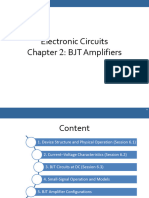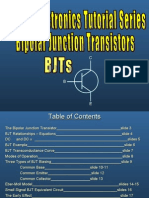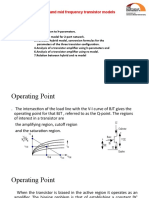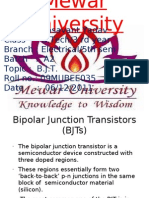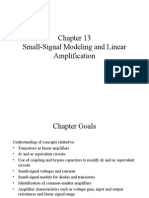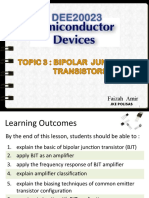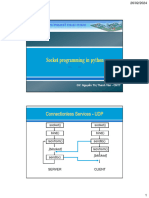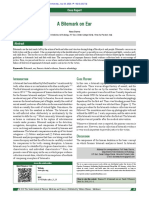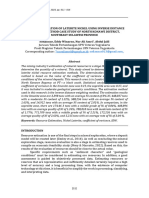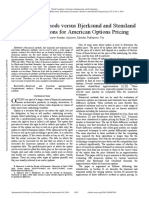15-Sep-20
Chapter 4
TRASITOR
Introduction
A transistor is a multipolar device capable of:
Increase (amplify) the current
Increase (amplify) the voltage
Increase (amplify) signal - Power
Bipolar Junction Transistor BJT (BJT-Bipolar Junction
Transistor) is the first generation transistor invented in
1947 by Bardeen, Brattain and Shockley
1
� 15-Sep-20
Transistor development process
Types of transistors
Types of transistors (TST): BJT, FET
BJT: Bipolar Junction Transistor: NPN conjunction transitor
Structure: 2 p-n contact layers facing each other
Classification: pnp & npn
Symbols: 3 poles B, C & E
Polarizing operation: off, saturation, amplification
2
� 15-Sep-20
NPN transistor
BJT iv characteristics includes four parameters
3
� 15-Sep-20
Currents on BJTs
With npn BJT
With pnp BJT
Operation modes
Depending on the value of the IB current, the
Transistor works as follows:
Modes BE CB
Off Reverse bias Reverse bias
Active Forward bias Reverse bias
Saturation Forward bias Forward bias
4
� 15-Sep-20
Operation modes
Transistor operates like a “valve:” iC & vCE are
controlled by iB
The principle of operation of the transistor
5
� 15-Sep-20
Cut-off operation
BJT operation in the “active” mode
6
� 15-Sep-20
Active mode (Chế độ khuếch đại)
α factor
β factor
Example
With the circuit above, assume βdc
factor =150. find IC, IB , IE and
voltage VCE , VCB
Using Kirchoff law
7
� 15-Sep-20
BJT operation in saturation mode
Saturation mode
Transistor saturate when:
IC > ICSAT
Notes: When the above
conditions is satify, the actual
current flow is ICSAT
8
� 15-Sep-20
Example
With the following circuit, assume saturation volt VCESAT
=0.2V, what is operation status of transitor
Current Ic if not saturate
Current Ic if saturate
Due to Ic > IcSat transitor staturated, real current through is
IcSat
DC load line
DC load line (đường tải tĩnh)
One-way load line is a straight
line drawn on the characteristisc
through two defined points:
Stop point, IC = 0
VCE= VCC (point M)
Saturation point: VCE = 0
IC = VCC/ RC (point N)
Connecting 2 points M and N,
we get a load line.
Equation for one-way load:
VCC=ICRC+VCE
Or
9
� 15-Sep-20
BJT iv characteristics:
iB = f(vBE) & iC = g(iB , vCE)
Early Effect modifies iv characteristics in
the active mode
10
� 15-Sep-20
1-way load line Role
Transistor circuit resolution.
Determine the static operating point Q.
Indicates the operating status of the transistor
(active, saturated, discontinued).
Amplification circuit is linear or not.
Amplified circuit design according to intention
(pre-select static Q point, calculate component
values)
NPN BJT iv equations
11
� 15-Sep-20
Recipe for solving BJT circuits
(State of BJT is unknown before solving the circuit)
1. Write down BE-KVL and CE-KVL:
2. Assume BJT is OFF, Use BE-KVL to check:
a. BJT OFF: Set iC = 0, use CE-KVL to find vCE (Done!)
b. BJT ON: Compute iB
3. Assume BJT in active. Set iC = β iB . Use CE-KVL to
find vCE .
If vCE ≥ VD0 , Assumption Correct, otherwise in saturation:
4. BJT in Saturation. Set vCE = Vsat . Use CE-KVL to find
iC. (Double-check iC < β iB )
NOTE: For circuits with RE , both BE-KVL & CE-KVL
have to be solved simultaneously
Example
12
� 15-Sep-20
Static operating point Q
The intersection point of the
electric line and the line of
polarization IB gives us the
value of static operating points
(Q).
The current gain varies with the
position of the operating point
Q.
The static operating point Q
changes position according to
the transistor polarization
voltage and also changes the ac
signal (AC) acting on the circuit.
Static operating point Q
13
� 15-Sep-20
Example
Find point Q with the following circuit and draw
DC load line, assume β=200
Transitor Bias
BJT has many applications in electronic devices, depending
on the specific application. BJT needs to provided proper
voltage and current for each pin. Polarization (bias) is the
asign of voltage on BJT poles. BJT polarization is to choose
DC power and resistance so that IB, IC, VCE have appropriate
values according to BJT's operation requirements according to
the operating areas of the transistor.
The general method for polarization circuit involves 3 steps
B1: Use the input circuit to determine the input current (IB or IE)
B2: Inferred the output current from the relation IC = βIB or IC = αIE
B3: Use output circuit to find the remaining parameters (voltage at the
pins, between the pins of BJT ...)
14
� 15-Sep-20
Fixed bias
Input circuit for BE (Base-Emitter):
With VBE = 0.7V
If BJT is Si and VBE = 0.3V
If is Ge.
Result : IC=βIB
Output circuit for BC(collector based)
This is DC load line equation
Saturated collector current
15
� 15-Sep-20
Example
With the circuit as follows. Find IB , IC , IE , VCE
Stable Bias the transmitter
Basically is the same as a fixed bias circuit, but at the
emitter pole is added an additional resistor RE to mass.
The calculate method also has the same steps as the fixed
bias circuit.
Input circuit BE
Replace
Result
Referece IC = βIB
16
� 15-Sep-20
Ouput circuit BC (collector-based)
Saturation collector current ICSat
Example
Give the following circuit. Find IB, IC, IE VCE
17
� 15-Sep-20
Bias by volt dividing bridge
Input circuit BE
Or
Ouput circuit BC
The saturation collector current
Example
Give the following circuit. Find IB, IC, IE, VCE .
Assume VBE =0.7, IE ≈IC
18
� 15-Sep-20
Bias with voltage feedback
Input circuit for BE
Replace IC = βIB
Output circuit CE
Example
With the circuit as following, find IB, IC, IE, VCE .
Assume VBE =0.7
Solution :
Input circuit for BE
Replace IC = βIB
Output circuit CE
19
� 15-Sep-20
BJT Small Signal Amplifier Circuit
Define
Amplification is the process of converting a quantity
(current or voltage) from a small amplitude to a large
amplitude without changing its form.
When considering BJT operating under small signal
condition (the change of input signal is small enough),
BJT can be considered as AC amplifier
Gain: is the ratio of a amount of signals (current
or voltage) that changes at the output and the
input
Notation:Ai hoặc AV
Current gain:
Voltage gain:
20
� 15-Sep-20
Capacitor: The property of the capacitor is to
prevent the DC signal, usually the capacitor will be
used to prevent the effect of the DC signal on the
source or load.
These capacitors must be large enough to have a
very small impedance to the AC signal.
These capacitors are called coupling capacitors or
blocking capacitors.
DC and AC load line
Consider amplify
circuit CE
DC Load resistor :
RL = RC
AC load resistor:
rL = RL // RC.
21
� 15-Sep-20
DC load line is a collection of all Q static working
points (IC, VCE), without AC signal.
AC load line is the collection of all points (iC, vCE),
including point Q.
Equation of the AC load
22
� 15-Sep-20
Maxswing mode
Is operates mode when the maximum output
voltage is reached without distortion.
To achieve this mode, the static bias point must
be chosen in the middle of the value Vmin ÷
Vmax.
23
� 15-Sep-20
Diagram of equivalent BJT
The purpose of transfer to the equivalent scheme is to
make the computational circuit simpler and easier.
When the variation in the input signal is small enough to
make the change in the output current and voltage within
the limited characteristic of the BJT, we can consider the
BJT as a linear 4-pole element:
I1, V1(i1, v1): current and volt at input
I2, V2(i2, v2): current and volt at
output
24
� 15-Sep-20
Equivalent circuit of BJT
Resistor in h11 (or hi).
Volt source h12v2 (or hr vo): represent feeback local volt of BJT.
Really, h12 (or hr) has small value (10-3 ÷10-4), so h12v2 can be
omitted.
Current source h21i1(or hfii): reflect ability of current amplify.
admitance h22(or ho), in realyty this value is very small, therefore
out resistance very large and can be omitted.
25
� 15-Sep-20
BJT equivalent circuit CE type
BJT equivalent circuit CB type
26
� 15-Sep-20
BJT equivalent circuit CC type
Common emitter amplifier (CE)
Circuit
27
� 15-Sep-20
AC equivalent diagram
Input resistance
28
� 15-Sep-20
Output resistance
Voltage gain
When no load, output is considered open circuit
Notes : output voltage inverse phase with input
voltage
29
� 15-Sep-20
Total Voltage gain (độ lợi áp toàn phần)
reference
30
� 15-Sep-20
Current gain
refer
with
31
� 15-Sep-20
Amplifier circuit common B
Equivalent circuit
Input resistance – output resistance
Notes: value of re very small therefore amplifier
type common B has input resistance small
32
� 15-Sep-20
Voltage gain
When no has load, output is considered open
circuit
33
� 15-Sep-20
Total voltage gain
Refer
34
� 15-Sep-20
Total current gain (Độ lợi dòng tổng)
Refer
35
� 15-Sep-20
Amplifier circuit with common C
Equivalent circuit
36
� 15-Sep-20
Input resistance
Output resistance (Điện trở ra)
37
� 15-Sep-20
Voltage gain (Độ lợi áp)
Without load, output is considered open circuit
Voltage gain
38







